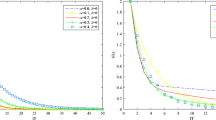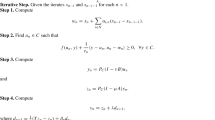Abstract
Reducible Runge-Kutta methods are characterized by means of special matrices. Previous definitions of reducibility are incorporated. This characterization may be useful in the study of algebraic stability and in studies of existence and uniqueness.
Similar content being viewed by others
References
K. Burrage and J. C. Butcher,Stability criteria for implicit Runge-Kutta methods. SIAM J. Numer. Anal. 16 (1979), 46–57.
G. J. Cooper,A generalization of algebraic stability for Runge-Kutta methods. IMA J. Numer. Anal. 4 (1984), 427–440.
M. Crouzeix, W. H. Hundsdorfer and M. N. Spijker,On the existence of solutions to the algebraic equations in implicit Runge-Kutta methods. BIT 23 (1983), 84–91.
G. Dahlquist and R. Jeltsch,Generalized disks of contractivity for explicit and implicit Runge-Kutta methods. Dept. of Comp. Sci., Roy. Inst. of Tech., Stockholm (1979), Report TRITANA 7906.
E. Hairer and H. Türke,The equivalence of B-stability and A-stability. BIT 24 (1984), 520–528.
W. H. Hundsdorfer and M. N. Spijker,On the algebraic equations in implicit Runge-Kutta methods. Dept. of Num. Maths., Centre for Maths. and Comp. Sci., Amsterdam (1984), Report NM-R8413.
P. Lancaster,Theory of Matrices,. Academic Press, New York (1969) 255–260.
Author information
Authors and Affiliations
Rights and permissions
About this article
Cite this article
Cooper, G.J. Reducible Runge-Kutta methods. BIT 25, 675–680 (1985). https://doi.org/10.1007/BF01936145
Received:
Issue Date:
DOI: https://doi.org/10.1007/BF01936145




